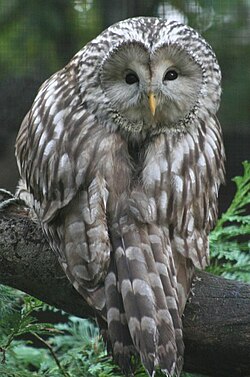Strix (genus)
| Strix | ||||||||||
|---|---|---|---|---|---|---|---|---|---|---|

Great gray owl ( Strix nebulosa ) |
||||||||||
| Systematics | ||||||||||
|
||||||||||
| Scientific name | ||||||||||
| Strix | ||||||||||
| Linnaeus , 1758 |
Strix is a kind of medium to very large types of authentics owl (Strigidae), in accordance with all species name as Käuze be referred to. Depending on the scientific opinion, it comprises 15–24 species that occur almost worldwide with the exception of the polar regions, Australis , Madagascar and the South Pacific islands. In Central Europe, the genus is represented by the tawny owl ( Strix aluco ) and by residual populations of the Ural Owl ( Strix uralensis ). The largest species of this genus occurs in northernEurope, the great gray owl ( Strix nebulosa ), which is common in the northern Holarctic .
Most of these largely nocturnal owls feed on small to medium-sized mammals, and occasionally birds and reptiles. They breed in natural tree hollows, in decayed tree stumps, old woodpecker holes and in crows and raptors' nests.
The genus has no obligatory migratory birds, but the species at higher latitudes undertake weather-related migrations when the prey animals become scarce or inaccessible.
In English this genus is called Wood Owls , in German, however, a comprehensive term under "Waldkäuze" is not in use. The generic name Strix was one of the many names for owls in ancient Greece.
About half of the species are not endangered. However, some have very small areas of distribution in which anthropogenic interventions in their habitat, especially deforestation , very quickly lead to population collapses. The stock situation of some other species is so far completely unclear.
features
Birds of this genus are usually massive-looking, medium-sized to very large owls with a strikingly large, round head and clearly pronounced facial veil. Feather ears are not formed in any type. Most of the species are colored brown, gray-brown or reddish brown on the upper side; Both light and dark drawings and irregular drop spots are embedded in this basic color, which gives the upper side plumage an effective camouflage color overall. Some species, such as the Malay Owl ( Strix leptogrammica ) or the Bartelskauz ( Strix bartelsi ), have a striking reddish orange-brown color. A few species have black and white speckled plumage, including the band - necked owl ( Strix nigrolineata ) and the zebra owl ( Strix huhula ) , which were formerly part of their own genus Ciccaba . The underside is usually lighter in color and has either dark vertical or horizontal dashes in different intensities. Many species are very variable in their basic color, some have different, mostly reddish-brown or gray-brown color morphs . High mountain or desert species, such as the two species oman owl ( Strix butleri ) and Himalayan tawny owl ( Strix nivicola ), which have long been listed as subspecies of the tawny owl , are sandy-colored or with dark spots on a very light, almost white background.
The visual field is often clearly brighter than the rest of the head plumage; in most species it is radially darkly zoned, in some other species, such as the Ural owl, it is structured in a radial manner. In most species it is clearly separated from the rest of the head plumage by either a dark or light, often clearly heart-shaped feather edge. Over the round, often not too large, dark brown eyes in the majority of species, but in some yellow or orange eyes, there is a light feather edge that narrows towards the beak and widens again under the beak, creating a striking x-shaped face drawing . In some species, this feather border under the beak is elongated like a beard. The relatively short, strong and strongly downwardly curved bill is yellow in almost all species. As in all Strigidae, the legs are short and strong and in almost all species they are feathered to the base of the toes. In some owls that occur in nival habitats, the basal toes also have feathers or - as in the great gray owl - are completely feathered.
The wings are broad and rounded. The tail is also relatively broad, of medium length or long, rounded in most species and more or less clearly transversely banded in many.
As with all owls, the sense of hearing is extremely well developed. The ear openings are very large and in most species, such as the barn owls ( Aegolius ), asymmetrical. This asymmetry is most pronounced in the great gray owl and includes not only the soft parts of the organ, but also the skull. Usually the right ear is larger than the left.
The sexes do not differ in color. With regard to size and mass, there is a slight, and in some cases also clear, reverse gender dimorphism . Males of the great gray owl weigh up to 1110 grams, while females weigh a maximum of 1900 grams.
measurements and weight
The smallest representatives, such as the Mexican owl ( Strix squamulata ), measure around 30 centimeters with a weight of around 300 grams; Females of the largest member of the genus, the great gray owl, reach a body length of 67 centimeters and a weight of almost two kilograms. So they are hardly inferior in size to the domestic eagle owl ( Bubo bubo ), but they are clearly in weight.
Vocalizations
The basic pattern of the chants of almost all representatives of this genre is very similar: it consists of a number of hu syllables of different sizes, but usually not exceeding 10 , which are presented in different ways and with emphasis. The sound characteristics can produce a dull booming, a pleasantly guttural but also a barking sound (sound example: great gray owl). In general, the pitch of the smaller species is slightly higher and brighter; in the large species, deep, hollow tones predominate. The vocalizations of the two South American rust-footed owl ( Strix rufipes ) and Chaco tawny owl ( Strix chacoensis ) differ significantly from this basic scheme, which after grunting input elements have a long sequence of relatively clear, guttural syllables, such as coconut-kwowkwok ... or crococro-craor- craor ... express (sound example: spotted owl). Both partners sing, often in a duet. Females sometimes have the same calls as the males, but these are often a little higher and rougher, and usually less loud. In addition, they have calls that are uttered primarily by them. The shrill kuwitt of the tawny owl is often the female's answer to the male's song of the territory (example of voice: tawny owl, song of the territory). In addition to these main chants and calls, a number of harsh and garish, screeching sounds belong to the vocal repertoire of these owls. Schnabelknappen can be heard in most representatives of this genus.
distribution
Owls of the genus Strix are represented in all fauna regions of the world with the exception of the polar regions, Madagascar, and the Australis . The ninox genus, which is similar in terms of habitat requirements, is widespread in the Australis . The greatest biodiversity of the genus Strix exists in Southeast Asia and in Central and South America. In central Europe there is only one species of the genus, the tawny owl ( Strix aluco ). This is the most common owl species here and populates almost all of Europe with the exception of Ireland and Iceland. Only in the northern and eastern or extremely south-eastern peripheral areas of Europe are three other members of the genus common: the Ural Owl ( Strix uralensis ), the Great Gray Owl ( Strix nebulosa ) and, extremely rarely, the Owl ( Strix butleri ).
Most species inhabit relatively large, contiguous areas. Except for the Niaskauz ( Strix niasensis ) and the Bartelskauz ( Strix bartelsi ), no island endemics are known. The large, dark Sichuan owl ( Strix davidi ) is endemic to the mountain forests of Sichuan . The yellow owl ( Strix fulvescens ) is only known from a small area in Central America. The great gray owl, which is Holarctic represented in the entire boreal zone , has by far the largest distribution area .
Habitats
All species of the genus Strix are bound to habitats with trees. Most populate open, tree-lined landscapes; dense forests are often avoided or only chosen as a habitat if there is sufficient open space available for hunting. Some species, such as the malay owl or the spotted owl , also occur in dense primary forests , and leave them when the structure is changed too much by logging. Often times the daylight is in denser forest areas, while more open landscapes are sought out for hunting. Desert and steppe species prefer riverside woodlands and palm groves in oases, the Chaco tawny owl ( Strix chacoensis ) occurs in dry scrubland with large cacti and small trees. In addition to original habitats, owls of this genus can also colonize highly anthropogenic landscape structures such as parks, cemeteries, large orchards or plantations. Some species seem to prefer to breed near human settlements. In addition to an adequate supply of food, the availability of nesting opportunities and daily stalls is a prerequisite for establishing a territory.
Representatives of this genus occur in lowland areas, in coastal regions and in the still sparsely tree-covered high mountains near the tree line. The African tawny owl, for example, breeds in gallery forests at sea level as well as in cloud forests at altitudes over 3700 meters. A subspecies of the tawny owl, Strix a , also penetrates to similar heights . biddulphi , in Kashmir in front of and at even greater heights, breeding grounds of the mountain owl ( Strix newarensis ) and the Sichuan owl have been found; the latter is said to occur up to an altitude of 5000 meters.
No summary information can be given about the average area sizes; the species are too different in their habits, their size and their geographical distribution.
Food and subsistence

Owls of this genus do not belong to the food specialists, but with certain preferences they prey on almost all prey that they can overwhelm. Small, crepuscular and nocturnal mammals predominate in most species. These include field mice , wood mice , shrews , rats , bank voles , lemmings , hamsters , gerbils , squirrels and flying squirrels as well as bats . The largest mammals that fall prey to these owls are young hares , rabbits, and mountain hares . In smaller, especially tropical species, insects, especially large beetles , cicadas , crickets and grasshoppers, can make up the main food component. Often birds up to the size of pigeon and hazel grouse belong in the prey scheme; they can become the main prey of northern species and mountain species in snowy winters when mammals become inaccessible. Amphibians such as frogs and newts are prey as well as various reptiles such as geckos , lizards and smaller snakes . In some species, fish play a not insignificant role. Bearded owls have rarely been observed on the carrion of larger mammals. Snails, worms and arachnids are eaten, especially when there is a great lack of food. The food composition of all species, especially those living in temperate and northern latitudes, is subject to great seasonal fluctuations.
In the tawny owl, which has been studied particularly well, the proportions of prey animals are composed as follows: 73 percent small mammals (at least 45 different species); 14 percent birds (around 100 different species, but mainly sparrows , chaffinches and green finches ) and 13 percent frogs and toads. An adult, medium-sized owl such as the tawny owl needs just under 100 grams of food per day. A non-breeding pair of large owls of this genus, such as the Ural Owl, require over 100 kilograms of food per year.
The majority of owls of this genus are nocturnal hide hunters , but they also master other hunting techniques. The bird overlooks its hunting area from a viewing point a few meters above the ground. Once it has located a prey animal visually or acoustically, it drops slidingly and hits the animal with a violent impact on the ground. The prey is killed with the sharp claws or by a bite in the neck. Smaller prey animals are kneaded with the toes and swallowed whole, larger ones cut up. Birds' large plumage is removed prior to consumption or feeding. As far as is known, most representatives of this genus can locate prey purely acoustically and seize them safely in complete darkness. Bearded owls can track down and beat small mammals under a blanket of snow up to 50 centimeters high. Occasionally , some Strix representatives shake over suspected prey.
In addition to this most common hunting method, one sees many Strix species hunt in a slow, low-level search flight. The resulting flight noises are so low due to the special nature and structure of the wings that are unique to all owls that neither the potential prey animals are warned, nor the hunting owl is hindered in the acoustic location. If an attack fails, the prey is no longer pursued. Bats and swarming insects are caught in flight. Squirrels or flying squirrels are able to strike some of these owls, such as the endangered spotted owl of western North America, directly on the trunk or on branches. Birds are surprised in their sleep, pushed by sleep and caught in flight. In snowy winters, forest owls can make themselves completely independent of the otherwise predominant food for small mammals. Occasionally you can see individual Strix owls on foot looking for prey.
As far as is known, food depots are only created by owls that inhabit cold zones. Indigestible food residues are choked out in characteristic bulges .
behavior
As far as is known, all representatives of this genus are largely nocturnal; only during the breeding season is the period of activity of some species extended into the twilight hours. Sometimes great gray owls, owls and occasionally tawny owls can be found hunting on cloudy days. These owls sleep through the day in good cover, usually sitting on a branch close to the trunk. They often go to sun-exposed areas to warm up. Many species are violently hated by small birds and crows .
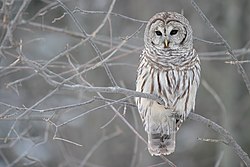
All of the species examined so far are territorial all year round. Outside of the breeding season, they live alone or in loose relationships; In the case of particularly good food conditions, for example in the case of mass reproduction of lemmings, the territoriality can be reduced. Usually, however, representatives of the Strix do not tolerate any conspecifics in the area apart from their partner. Other owls are also driven away if possible. Some species are extremely aggressive, especially during the breeding season, and also vehemently attack people who come too close to the nesting site.
The majority of the species remain in the area all year round, this applies in particular to all species distributed in subtropical and tropical regions. Species that inhabit cold zones are usually forced to migrate when there is very high snowfall; Northern Siberian birds and those of Alaska and Northern Canada generally show an increased willingness to migrate southwards. In some representatives of the species, nomadic behavior is observed. Bearded owls can appear in regions where they have not been found for decades if there is good food available. The mobility of juvenile birds is generally greater than that of adult birds, but the dismigration distances are usually quite short. In a large American study, 158 ringed barnacles were found within a radius of 10 kilometers from the ringing location; on the other hand, long migrations are also possible: A bird of the same species ringed in Nova Scotia was found again a year later at a distance of over 1,600 kilometers in Ontario.
Breeding biology
Almost nothing is known about the breeding biology of a good half of all owls of the genus Strix . As far as studies are available, all species become sexually mature at the end of their first year of life. They lead a largely monogamous seasonal marriage. In some, the pair bond does not expire after the breeding season, so that re-breeding is the rule. Most species are cave-breeders , who choose natural tree hollows, woodpecker holes or rotten tree or branch stumps as nesting opportunities. But also crow and raptor nests as well as squirrel scoop are used, building, rock and ground broods also occur. Some species accept nesting boxes. Nesting material is not entered by any species.

Most species only appear to breed once a year. Second broods are likely in some tropical species. Second and even third broods are known of the American barred owl. As with all owls, the clutch size is heavily dependent on the food available; it varies between one and six mostly pure white, round oval eggs. The most common seem to be 2 and 3 clutches. If the food supply is very poor, these owls do not breed or break off the brood. The eggs of the small species measure around 42 × 36 millimeters and weigh around 30 grams, while the eggs of the largest species measure around 57 × 46 millimeters and weigh around 50 grams. The incubation period is relatively close to each other at around 30 days for all species. It only breeds the female. Only once was a male observed on a clutch of the oman owl. During the breeding season and later during the first few weeks of rearing the young, the male alone produces food. In many, but not all species, the young leave the nest as branches long before they fled; from this point on, the female participates in the foraging for food. The young of the little oman owl fled after about 40 days, those of the tawny owl need a full seven weeks to achieve full flight ability. In contrast, the young of the much larger great gray owl are able to fly at around 42 days. The duration of the tour, during which the fledglings continue to be looked after by the adults, varies in length. The tropical species seem to be the fastest to become independent; in the large boreal owls and some high mountain species it lasts over two months. The little Mexico owl leads its offspring for up to three months.
Life expectancy
Most members of the genus do not have any data on life expectancy. The available data show, however, that owls of the genus Strix can get relatively old. However, a high percentage of young birds do not survive the first year of life. The oldest great gray owl living in the wild was 17 years old when it died, the maximum age of the tawny owl is known to be around 19 years. Similar information is available for the barred owl and the spotted owl. In captivity, a great gray owl lived to be over 27 years old.
Systematics
Strix is a monophyletic genus within the Striginae subfamily that can be distinguished morphologically, behaviorally and, if known, genetically from other genera of the Strigidae . Together with the monotypic genera Jubula and Lophostrix and the genus Pulsatrix , which comprises four species , they currently form the tribe Strigini. However , according to the latest DNA findings, it seems at least questionable whether the three last-mentioned genera can actually be combined with Strix in a tribe.
König & Weick currently differentiate between 24 species. The last edition of the AOU checklist included 20 species. The differences result from the fact that the AOU lists the S. niasensis , S. bartelsi and S. newarensis listed as subspecies of the Malay owl, Strix leptogrammica , and the Mexico speckled owl ( Strix squamulata ) as a subspecies of König & Weick South American owl ( Strix virgata ) counts. In addition, König & Weick have assigned four South American species of the genus Ciccaba to the genus Strix .
16 species appear in the HBW species list . The four taxa listed by König & Weick from the Malay Owl Complex are regarded as subspecies of Strix leptogrammica and the genus Ciccaba , which König & Weick after Strix , appears again as an independent genus with four species.
| German name | Scientific name | distribution | Hazard level Red List of IUCN |
Remarks | image |
|---|---|---|---|---|---|
| African Tawny Owl |
Strix woodfordii ( A. Smith , 1834) |
Sub-Saharan Africa Southeast Africa |
|
4 subspecies |

|
| Great gray owl |
Strix Bartelsi ( Finsch , 1906) |
West Java |
|
According to AOU subspecies of S. leptogrammica |
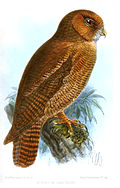
|
| Great gray owl |
Strix nebulosa J. R. Forster , 1772 |
northern holarctic |
|
2 subspecies |
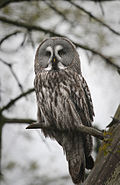
|
| Mountain owl |
Strix newarensis ( Hodgson ), 1836 |
Himalaya, Punjab , Nepal , Sikkim eastwards to Vietnam |
|
According to AOU subspecies of S. leptogrammica 4 subspecies |
|
| Band-necked owl |
Strix nigrolineata ( PL Sclater , 1859) |
Southern Mexico, Central America, NW South America |
|
According to the South American Classification Committee (SACC) Ciccaba nigrolineata monotypical |

|
| Brazilian owl |
Strix hylophila Temminck , 1825 |
SO Brazil, E + S Paraguay, NE Argentina |
|
monotypical | |
| Chaco tawny owl |
Strix chacoensis Cherrie & Reichenberger , 1921 |
Chaco of Bolivia , Paraguay and Northern Argentina |
|
monotypical was previously considered UA of S. rufipes |

|
| Spotted owl |
Strix occidentalis ( Xantus , 1860) |
Western North America |
|
3 subspecies |

|
| Owl |
Strix fulvescens ( PL Sclater & Salvin , 1868) |
Southern Mexico to Honduras | Uncertain, according to IUCN |
monotypical Some authors consider it to be UA of S. varia |
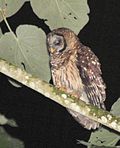
|
| Ural Owl |
Strix uralensis Pallas , 1771 |
Northern Palearctic; Relic occurrences in Central and SE Europe |
|
8 subspecies |

|
| Malay Owl |
Strix leptogrammica Temminck , 1832 |
India, Sri Lanka , Malaysia , Sumatra, Kalimantan |
|
5 subspecies - at König & Weick split into 4 types |

|
| Mango Owl |
Strix ocellata ( Lesson , 1839) |
Himalayas, India |
|
3 subspecies |

|
| Niaskauz |
Strix niasensis ( Salvadori , 1887) |
Endemic to Nias, west of Sumatra |
|
According to AOU subspecies of S. leptogrammica | |
| Omani owl |
Strix omanensis Robb , van den Berg & Constantine , 2013 |
So far only known from photos from the Hajar Mountains in Oman ; its independence or relationship to the Omankauz is the subject of further investigations |
|
according to the IOC World Bird List is a junior synonym of Strix butleri | |
| Pagoda owl |
Strix seloputo Horsfield , 1821 |
Southeast Asia, Sumatra , Java |
|
3 subspecies |

|
| Red owl |
Strix albitarsis ( Bonaparte , 1850) |
Eastern Andes south to Bolivia | Uncertain; probably rarely - according to IUCN |
monotypical; occasionally 3 UA are mentioned. According to the South American Classification Committee (SACC) Ciccaba albitarsis is monotypic |
|
| Rust-footed owl |
Strix rufipes King , 1827 |
Central Chile , Patagonia |
|
monotypical |
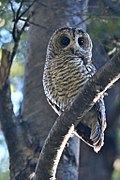
|
| Sichuan Owl |
Strix davidi ( Sharpe , 1875) |
Isolated in the mountains of Sichuan |
|
monotypical Some authors consider it UA of S. uralensis |
|
| Barred owl |
Strix varia Barton , 1799 |
Southern Canada, Eastern, NW USA, Northern Mexico |
|
3–4 subspecies - The Mexican subspecies ( S. v. Sartori ) received species status as Strix sartorii due to considerable genetic and morphological differences . |

|
| South American minky owl |
Strix virgata ( Cassin , 1849) |
South America east of the Andes south to northwest Argentina |
|
4 subspecies; According to the South American Classification Committee (SACC) Ciccaba virgata monotypical |
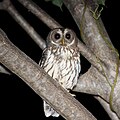
|
| Mexico minky owl |
Strix squamulata ( Bonaparte , 1850) |
Mexican Atlantic, Pacific coast Central America , NW South America |
|
3 subspecies Often subspecies of S. virgata |
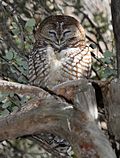
|
| brown owl |
Strix aluco Linnaeus , 1758 |
Europe, eastward to Central Asia, isolated in the Himalayas and Kashmir |
|
at least 8 subspecies |

|
| Himalayan Tawny Owl |
Strix nivicola ( Blyth , 1845) |
Himalayas, central and southern China eastwards to the Yellow Sea , Taiwan |
|
3 subspecies Sometimes UA from S. aluco |
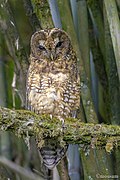
|
| Gray owl |
Strix hadorami Kirwan , Swiss & Copete , 2015 |
Israel, Jordan, Sinai Peninsula, eastern Egypt to the north of Sudan and in places on the Arabian Peninsula (Saudi Arabia, Yemen and southern Oman) |
|
no subspecies described yet |
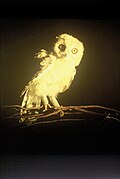
|
| Granny owl |
Strix butleri ( Hume , 1878) |
Levant , Arabian Peninsula |
|
No subspecies sometimes as a subspecies of S. aluco viewed |
|
| Zebra owl |
Strix huhula Daudin , 1800 |
South America east of the Andes south to N-Argentina |
|
According to the South American Classification Committee (SACC) Ciccaba huhula 2 subspecies. |
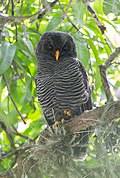
|
Existence and endangerment
According to the IUCN, which lists only 18 species, only two species, Strix hylophila and Strix occidentalis, are on the alert level. König & Weick see potential threats to a number of other species. The greatest threat to a number of species appears to be from the uncontrolled deforestation of habitats in some places. In North America this allows the barred owl to spread westwards, but is increasingly displacing the spotted owl, which is bound to dense forest sections.
Very little is known about some of the species so that a reliable population assessment is not possible.
literature
- Urs N. Glutz von Blotzheim (Hrsg.): Handbook of the birds of Central Europe . Volume 9: Columbiformes - Piciformes. 2nd Edition. Aula-Verlag, Wiesbaden 1994, ISBN 3-89104-562-X .
- James R. Duncan: Owls of the World . Firefly Books, Buffalo 2003, ISBN 1-55297-845-1 .
- Jochen Hölzinger , Ulrich Mahler: The birds of Baden-Württemberg. Non-singing birds. Volume 3, Ulmer, Stuttgart 2001, ISBN 3-8001-3908-1 .
- Claus König, Friedhelm Weick: Owls of the World . Christopher Helm, London 2008, ISBN 978-0-7136-6548-2 .
- Theodor Mebs : Owls and Owls . Kosmos, Stuttgart 1987, ISBN 3-440-05708-9 .
Individual evidence
- ↑ HBV Volume 9 (1980) p. 578.
- ↑ König & Weick (2008) p. 383.
- ↑ König & Weick (2008) pp. 354–384.
- ↑ Sound example: Great gray owl . owlpages.com. Retrieved November 10, 2019.
- ↑ Sound example: Spotted Owl . owlpages.com. Retrieved November 10, 2019.
- ^ Tawny Owl, Reviergesang . birdsongs.it. Retrieved November 10, 2019.
- ↑ König & Weick (2008) p. 366.
- ↑ König & Weick (2008) p. 362 and 360
- ↑ König & Weick (2008) p. 384.
- ↑ Mebs (1987) p. 32.
- ↑ HBV Volume 9 (1980) p. 609.
- ↑ HBV Volume 9 (1980) p. 628.
- ↑ König & Weick (2008) p. 384.
- ↑ König & Weick (2008) p. 378.
- ↑ König & Weick (2008) p. 379.
- ↑ König & Weick (2008) pp. 365–384.
- ↑ König & Weick (2008) p. 365.
- ↑ König & Weick (2008) p. 369.
- ↑ König & Weick (2008) p. 384.
- ↑ König & Weick (2008) pp. 54–55.
- ↑ König & Weick (2008) pp. 354–384 (remarks on the individual articles)
- ^ AOU World Checklist
- ↑ W. Holt, R. Berkley, C. Deppe, P. Enríquez Rocha, JL Petersen, JL Rangel Salazar, KP Segars, KL Wood, Guy M. Kirwan :? In: J. del Hoyo, A. Elliott, J. Sargatal, DA Christie, E. de Juana (Eds.): Handbook of the Birds of the World Alive. Lynx Edicions, Barcelona 2015, p.?.
- ↑ SACC data sheet, engl.
- ↑ Elsie Naumburg's first publications were made under the name of her husband, Victor Reichenberger
- ↑ J. del Hoyo, N. Collar, Guy M. Kirwan: Omani Owl (Strix omanensis) . In: J. del Hoyo, A. Elliott, J. Sargatal, DA Christie, E. de Juana (Eds.): Handbook of the Birds of the World Alive. Lynx Edicions, Barcelona 2014. (accessed January 12, 2015)
- ↑ SACC data sheet, engl.
- ^ IOC vers. 2.11, Jan 2012
- ↑ data sheet SACC engl.
- ↑ Guy M. Kirwan, Manuel Schweizer, José Luis Copete: Multiple lines of evidence confirm that Hume's Owl Strix butleri (AO Hume, 1878) is two species, with description of an unnamed species (Aves: Non-Passeriformes: Strigidae). In: Zootaxa. 3904, 1, 2015, pp. 28-50.
- ↑ W. Holt, R. Berkley, C. Deppe, P. Enríquez Rocha, JL Petersen, JL Rangel Salazar, KP Segars, KL Wood, Guy M. Kirwan: Hume's Owl (Strix butleri). In: J. del Hoyo, A. Elliott, J. Sargatal, DA Christie, E. de Juana (Eds.): Handbook of the Birds of the World Alive. Lynx Edicions, Barcelona 2015.
- ↑ SACC data sheet, engl.
- ^ Strix in the IUCN Red List of Threatened Species . Retrieved February 2, 2009.
